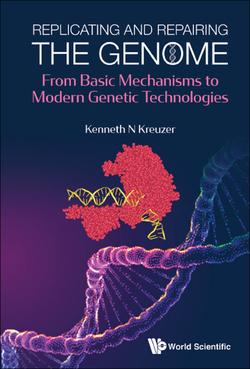Читать книгу Replicating And Repairing The Genome: From Basic Mechanisms To Modern Genetic Technologies - Kenneth N Kreuzer - Страница 30
На сайте Литреса книга снята с продажи.
3.1The E. coli replisome from 30,000 feet
ОглавлениеTo a first approximation, the E. coli chromosome is replicated in its entirety by just two replisome complexes loaded at a single origin site on the chromosome (also see Chapter 5). These two replisomes traverse the circular chromosome in opposite directions at a speed of roughly 1000 base pairs per second, and meet up to complete replication in a special terminus region on the opposite side of the circle. This speed, while quite impressive, is not quite high enough to explain how the bacterial cell can divide every 20 minutes (1000 base pairs/second × 60 seconds/minute × 20 minutes/division cycle × 2 replication forks = 2.4 million base pairs, only about half the number in the genome). This riddle is solved by the fact that E. coli and other bacteria actually carry out multiple rounds of replication at the same time under conditions of rapid cell division. Thus, two or three replisomes may be following each other around the chromosome at any one time, and partially replicated chromosomes must be segregated to daughter cells at the time of cell division (see Chapter 5).
A key question about DNA replication in the context of a living cell is whether the replisome is motoring along a relatively fixed DNA molecule or whether the DNA is slithering through a relatively fixed replisome. In the latter case, the DNA could actually be transported or “pumped” from one region of the cell to another during the act of replication. Scientists have been able to approach this question by placing visible markers (fluorophores) on the E. coli replisome proteins or, in a different experiment, particular locations of the chromosomal DNA. Strikingly, the replication proteins tended to remain near the middle of the cell throughout the period of DNA replication, while specific locations of the chromosome migrated in the cell. As replication progressed, the two duplicated copies of any particular chromosomal region moved in opposite directions from near the center of the cell toward the two poles. In this way, the movement of the duplicated chromosomes in preparation for bacterial cell division is coordinated with the act of replication. The separation of the two duplicated copies of the chromosome is made very challenging by the fact that each duplicated copy contains one of the two strands of parental DNA, and these two parental strands were wrapped around each other once every 10 or so base pairs before replication occurred. We will return to these topological issues in Chapter 7.
